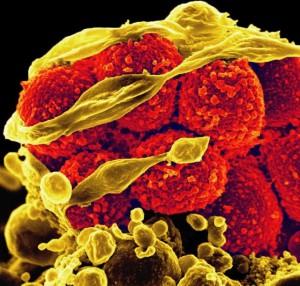Antibiotic-resistant bacteria transmission between humans and livestock
A recent study in the journal Applied and Environmental Microbiology found that antibiotic-resistant strains of the bacteria Staphylococcus aureus (which can cause what are commonly referred to as Staph infections) have been transferred from livestock to humans, and that these strains may persist in the hospital environment. Researchers analyzed whole genome sequences of the strain CC398 sampled from hospitals and livestock. They found that over time, the bacteria had been transferred multiple times from livestock into humans and from humans into livestock. They also found that the transmission of strains of bacteria resistant to tetracyclines was much more common from livestock to humans than from humans into livestock, suggesting that livestock may be an important source of infection in humans. Typically, bacteria from livestock infect humans who are exposed to animals on a regular basis, such as on a farm or in the meat packing industry. However, strains of the antibiotic-resistant bacteria were found in three samples taken from the newborn section of the hospital, suggesting that the bacteria may remain persistent in humans. These results are particularly troubling because “despite reports of a decline in the use of tetracyclines in human clinical settings and a ban on their use as livestock growth promoters in Europe since the 1970s, tetracyclines are still routinely added to animal feed in other countries, as well as being administered in therapeutic doses on commercial farms.”



